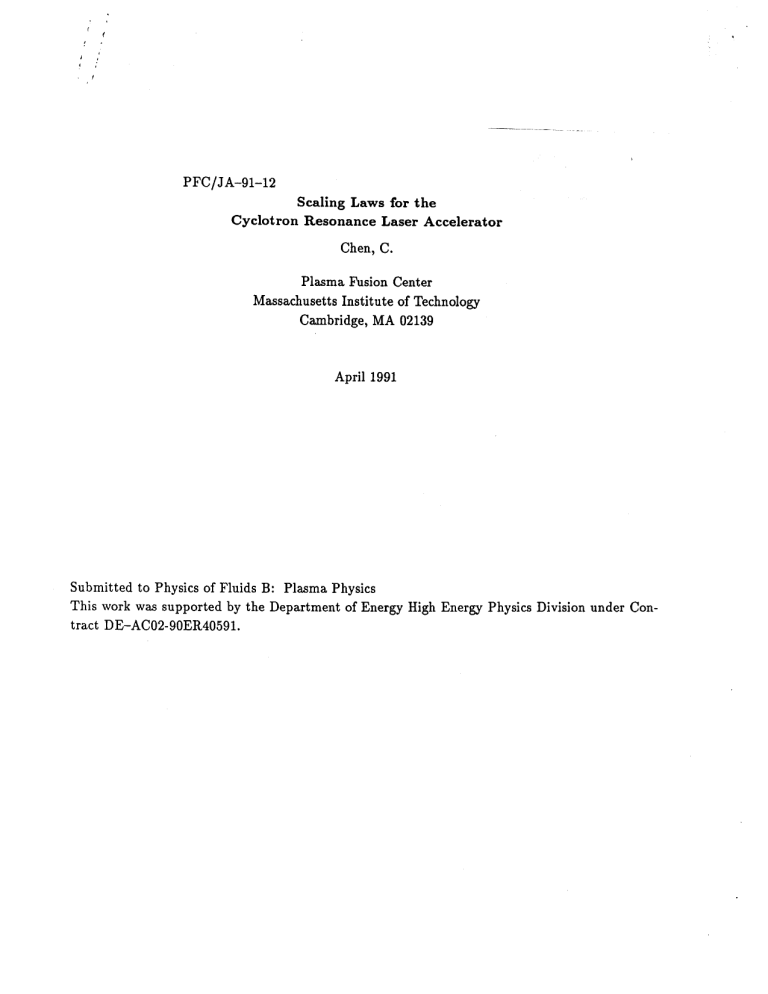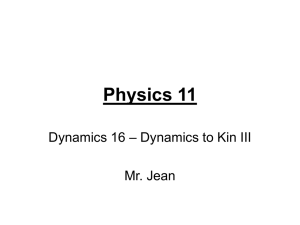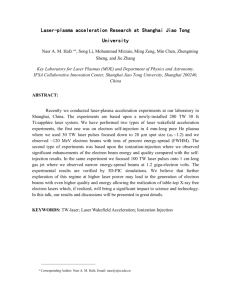PFC/JA-91-12 Scaling Laws for the C.
advertisement

PFC/JA-91-12
Scaling Laws for the
Cyclotron Resonance Laser Accelerator
Chen, C.
Plasma Fusion Center
Massachusetts Institute of Technology
Cambridge, MA 02139
April 1991
Submitted to Physics of Fluids B: Plasma Physics
This work was supported by the Department of Energy High Energy Physics Division under Contract DE-AC02-90ER40591.
Scaling Laws for the Cyclotron Resonance Laser Accelerator
Chiping Chen
Plasma Fusion Center
Massachusetts Institute of Technology
Cambridge, Massachusetts 02139
ABSTRACT
The nonlinear interaction of a tenuous continuous electron beam with a traveling
electromagnetic wave in the cyclotron resonance laser accelerator is analyzed using a
single-particle model and multi-particle simulation. It is found that the maximum beam
energy gain and acceleration distance obey certain scaling laws for optimized systems,
and that the maximum energy gain is limited primarily by the degree of wave dispersion
and is almost independent of the wave amplitude.
PACS numbers: 42.52.+x, 52.75.Ms
1
There has been considerable interest recently in laser accelerators' with the potential for achieving high accelerating gradient. One of such systems is the electron cyclotron
resonance laser (CRL) accelerator 2 that makes use of the resonant interaction of a coherent electromagnetic wave with a beam of electrons gyrating in a (guide) magnetic field.
An intriguing feature of the CRL mechanism is autoresonance,3 4 that is, the synchronism
between the electrons and laser field is self-sustained in the course of acceleration in an
ideal situation so long as the system is initially in synchronism. Although recent proof-ofprinciple experiments-
7
have successfully demonstrated the acceleration of electrons to
moderately relativistic energies using microwaves and the technique of tapering the guide
field, there are severe limitations posed by laser field dispersion, synchrotron radiation
losses, and the available strength of magnetic field in laboratories.
In this Letter, we examine the effects of laser field dispersion on the performance of
CRL accelerators. In particular, the nonlinear interaction of a tenuous continuous electron beam with a traveling electromagnetic wave in a tapered guide field is analyzed using a one-dimensional single-particle model and three-dimensional, self-consistent, multiparticle simulation. The dynamical bunching of the beam electrons in a synchronous
phase validates the use of the single-particle model. It is found in the single-particle
model, and confirmed in the multi-particle simulation, that the maximum beam energy
gain and acceleration distance obey certain scaling laws for optimized systems, and that
the energy gain is limited primarily by the degree of laser field dispersion and is almost
independent of the strength of the laser field.
We first consider the motion of an individual electron in the field configuration consisting of a right-hand circularly polarized electromagnetic wave (w, k1l?,) and a linearly
tapered guide magnetic field (with V - B = 0 = V x B)
$(i) = Bo 1 +
(
) F.
2
(x4+yiy),
eB XF
(1)
where L = BJ'dB,(z)/dz characterizes the degree of the taper. The normalized vector
potential of the wave and guide fields can be expressed as
eA(i)
[
QcYZ
+ a cos(k Iz - wt) ].
+ [
2L2 - a si(kI z - wt)]J
.
(2)
In Eq. (2), m and -e are the electron mass and charge, respectively; c is the speed of light
in vacuo; Qeo = eBo/mc = const. is the nonrelativistic cyclotron frequency; kl = 27r/A
and a = eE/wmc are the (axial) wave number and normalized wave amplitude of the
laser field, respectively.
When synchrotron radiation losses are negligibly small, the dynamics of an individual electron can be described by the Hamiltonian
H(S, P, t) = [(cP. + eA.)
2
+ (eP + eA,)
2
+ c2 p2 + m2 c4]'/ 2
By performing a time-dependent canonical transformation from
.
(3)
(i, P) to (4, 4, z', PO, PO,
P,,), and assuming the transverse drift of the electron guiding center be small (with
0 a 0 m P#), it can be shown that the Hamiltonian in the new variables is an approximate
constant of motion and can be expressed in the forms
H'(4, z', P0, Pz') = -wPo + -ymc2
-wP4+f{2mc
2
8 l(z')P4]1 2 cos 4k+c2 (P' +k P) 2 + (a2
+(z')P4+2a[2mac
11
1)m2c4}1/2.
(4)
Here, z = z' is the axial distance; Pz = Pe + k11P and ymc2 are the axial momentum
and total (rest plus kinetic) energy of the electron, respectively; 0,(z) = eB,(z)/mc is a
z-dependent nonrelativistic cyclotron frequency. Because Eq. (1) can be generalized to
3
represent arbitrary piecewise linear taper, the Hamiltonian in Eq. (4) provides a good
approximation to the problem for a continuous tapering of the guide field.
The constancy of H' can be interpreted as follows. For an untapered system, the
Hamiltonian in Eq. (4) is independent of z'. Thus, P, is a constant of motion, and the
total axial momentum of the (electron plus photon) system is conserved, i.e., P.+ nhkll =
P., +k 1 P0+nhkk1 = const., where n is the number of photons in the laser field and h = 27rh
is the Planck constant. As Sn photons are emitted or absorbed, from the conservation
of axial momentum, it follows that the change in P is given by SP0 = -Snh. On the
other hand, from the conservation of energy, we have S-ymc 2 = -Snhw.
This leads to
SH' = -w6P0+6-Ymc 2 = 0. Therefore, the constancy of H' states simply the conservation
of total energy of the system.
The electron phase 4 and energy ymc2 evolve according to the Hamilton equations
d4
dt
dt
+ 1k/2mc
1 [Q + -m(P.,
+ kP4 ) + a
M
2 1g\ 1/2
Pk
)
c k
Cos
(5)
and
dy 'wa
dt
-
2nP4
MC2
)
)1/2
sin 4.
(6)
At the cyclotron resonance, w = f)c/-y + kllv,, the electrons with different initial phases
are rapidly bunched around a synchronous phase of 4, = 7r/2 by the sinusoidal forcing
term in Eq. (5), and then they act like a macro-particle if the resonance is sustained. It
is this bunching effect that justifies the validity of the single-particle approximation to
the multi-particle problem.
For a non-dispersive laser field with
3
ph
w/ck
= 1 and a uniform magnetic
field Qc(z) = Qo, it can be easily shown from Eqs. (5) and (6) that for 4 =
4
=r/2,
-y(Lo-kv) = const., corresponding to the autoresonance condition. Moreover, integrating
Eq. (6) with
y(t)
-
4=
7r/2 and flc(z) = 0co yields the well-known asymptotic scaling relation'
a 2 /(9qco/2w)1/
3
(ot)2/3, resulting in infinite acceleration as t -+ 00.
In practise, the driving laser field is dispersive with ph > 1, resulting in the violation
of the autoresonance condition.
In this case, magnetic field tapering can be used to
maintain a stationary phase for the electron. By analyzing the Hamiltonian dynamics of
the electron in various tapered guide field profiles, we find that the maximum electron
energy gain can be obtained by choosing an optimal taper such that 4(t) ~~4, = 7r/2
for the entire acceleration process. Figure 1 shows typical results of such an analysis.
In Fig. 1, the electron kinetic energy and optimal axial magnetic field are plotted as a
function of acceleration distance, for the choice of a = 0.05,
fh
= 1.001, and the initial
conditions: z = 0, 11co/ckyj = 0.595, 4o = 7r/2, -y = 1.15, and vio/v.o = 0.2 (initial pitch
angle). The phase variation is found to be within ±8* for the normalized acceleration
distance from k 1z = 0 to 500. It is evident in Fig. 1 that the degree of the taper has
to become increasingly large in order to maintain the synchronous phase at the end of
acceleration. Such an abrupt termination of acceleration allows us to estimate accurately
the values of maximum electron energy gain and maximum acceleration distance zm.
Typically, the axial magnetic field at the end of the acceleration is about twice its value
at z = 0.
The maximum beam energy gain and acceleration distance for optimized systems are
calculated using the single-particle model and there-dimensional, self-consistent, multiparticle simulation, for a wide range of system parameters and initial conditions. The
simulation has been performed in the microwave regime using a code' that has been
developed initially for the study of the cyclotron autoresonance maser (CARM) amplifier
and described in our earlier work.' (Because the equations of motion are the same for
the CARM amplifier and CRL accelerator, the code can be used to study both.) We
5
find that the maximum beam energy gain is limited primarily by the degree of laser field
dispersion, while there is no substantial increase in energy gain as the wave amplitude is
increased. We also find that the maximum acceleration distance scales as kgzm oc 1/a,
that is, the acceleration gradient is proportional to the wave amplitude.
Figure 2 shows logarithmic plots of the maximum kinetic energy gain, (-yf --yi)/(yi 1), and the maximum (normalized) acceleration distance, kllzm, as a function of
1, a measure of microwave dispersion. Here, -yjmc2 and
-yfmC2
Oh -
are the average initial
and final energy for the beam electrons, respectively. In Fig. 2, the choice of system
parameters corresponds to a = 0.01 and w/27r = 9.55 GHz. The initial conditions in
the single-particle analysis are yi = 1.15, qo = 7r/2, vio/v2o = 0.05, and w = k11v.O +
Qlco/7i; the initial conditions in the simulation are the same as these in the single-particle
analysis, except that the initial phases of 1024 particles, 4o, are distributed uniformly
from 0 to 27r; In the simulation, the TE11 mode of cylindrical waveguide is used, and
the microwave power is adjusted to yield a normalized wave amplitude of a = 0.01 on
the z axis as the waveguide radius (or ph) is varied. (The inclusion of waveguide effects
results in somewhat longer acceleration distances than those from the one-dimensional
single-particle analysis.) The best fit of data obtained from the one-dimensional, singleparticle analysis shows that the maximum kinetic energy gain and normalized acceleration
distance satisfy the scaling relations (for ph > 1)
-i
i Oc
(#p
-
(7)
-Yi - I
k1jzm OC (ph
-
1)'
,
(8)
with p a 0.5 and v 2 0.6, which are in agreement with the results from the multi-particle
simulation.
6
In summary, it was found that there exist a maximum energy threshold and a
maximum acceleration distance, which have not been reported in earlier studies of CRL
accelerators.
It was shown in a one-dimensional single-particle model, and confirmed
in three-dimensional multi-particle simulations, that the maximum energy gain and the
maximum acceleration distance obey certain scaling laws for optimized systems, and that
the maximum energy gain is limited primarily by the degree of laser field dispersion and
is almost independent of the strength of the driving wave field. These scaling laws are
important for future CRL accelerator experiments.
ACKNOWLEDGMENTS
The author wishes to thank George Bekefi for discussion and encouragement. This
work was supported by the Department of Energy High Energy Physics Division under
Contract No. DE-AC02-90ER40591.
7
REFERENCES
1. Laser Acceleration of Particles,AIP Conf. Proc. No. 91, edited by P.J. Channell
(American Institute of Physics, New York, 1982).
2. P. Sprangle, L. Vlahos, and C.M. Tang, IEEE Trans. Nuclear Sci. NS-30, 3177
(1983).
3. C.S. Roberts and S.J. Buchsbaum, Phys. Rev. 135, 381 (1964).
4. H.R. Jory and A.W. Trivelpiece, J. Appl. Phys. 39, 3053 (1967).
5. D.B. McDermott, D.S. Furuno, and N.C. Luhmann, Jr., J. Appl. Phys. 58, 4501
(1985).
6. K.S. Golovanevsky, IEEE Trans. Plasma Sci. PS-10, 120 (1982); Sov. J. Plasma
Phys. 11, 174 (1985).
7. R. Shpitalnik, C. Cohen, and F. Dothan, and L. Friedland, preprint (1990).
8. C. Chen (unpublished).
9. C. Chen and J.S. Wurtele, Phys. Rev. Lett. 65, 3389 (1990), and manuscript
submitted to Phys. Fluids B (1990).
8
FIGURE CAPTIONS
Fig. 1
The kinetic energy of an electron (solid curve) and optimal (normalized) axial
magnetic field (dashed curve) as a function of the normalized acceleration
distance kjiz, for a
1,o/chij = 0.595,
Fig. 2
=
0.05,
Oh
= 1.001, and the initial conditions z = 0,
; = 1.15, 40 = 7r/2, and vio/vo = 0.2.
Shown in (a) the maximum kinetic energy gain and (b) the maximum
normalized acceleration distance as a function of fh
- 1, for a = 0.01,
w/27r = 9.55 GHz, and an initial kinetic energy of 67 keV (-y; = 1.15) for the
beam electrons. The open squares (solid circles) are the results from the
single-particle model (simulation), while the solid lines are the best fit of data
from the single-particle analysis.
9
8.0
2.0
6.0
1.6
4.0
1.2
2.0
-
0.8
0.4
0.0
0.0.
-
400.0
200.0
k z
Fig.
1
10
600.0
1000
z
100
(a)
-
rA
0D
z
10
I
I
II
I
111
11
I
1
11-
11
I-'
10~ 4
10-
3
I1o -
I
I1
1o
10~1
I
I
111111
I
I
I
liii
0
0
10 3
0
0
o
*
0
(b)
1021
10 -4
I
I
I
I
I
I I
i
I
I
I
I
I
I I I
1I ,
,I
II
I
I
I
lull
I I
I
10~'
Oph -
l
Fict.
2
i
I
I
I
I
i I I
A
lou




